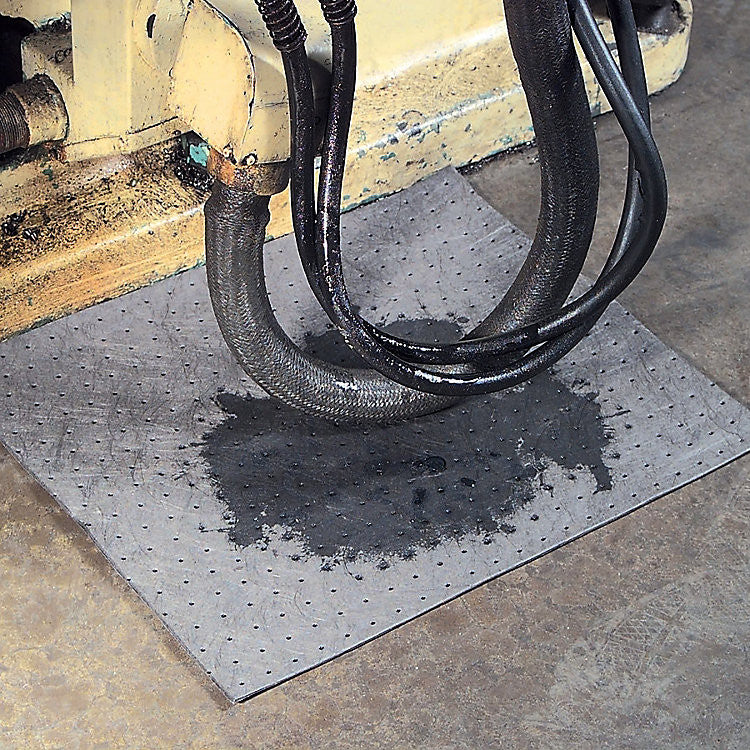
Improve Safety by Using the Right Absorbents
Slips, trips and falls can lead to both mi nor and serious work-related injuries as well as lost production time. Most of these incidents occur on wet surfaces, so avoiding accidents depends on implementing a safety plan to keep floors clean and dry. New Pig can help you choose the right products to use in your workplace safety plan.
nor and serious work-related injuries as well as lost production time. Most of these incidents occur on wet surfaces, so avoiding accidents depends on implementing a safety plan to keep floors clean and dry. New Pig can help you choose the right products to use in your workplace safety plan.
Clay and Cardboard Can Do More Harm Than Good
Leaks, drips and spills are rarely one-absorbent-fits-all incidents, but many workplaces only rely on cheap clay pellets and free cardboard to soak up any unwanted or extra liquid at job sites.
On the surface, clay pellets and cardboard are economical. These two “absorbents,” however, have many overlooked flaws and often do more harm than good.
Clay pellets are cheap — about $15 for a 40-pound bag — but are not porous, so they don’t absorb liquid. Pellets also contain crystalline silica and prolonged exposure can cause silicosis, a respiratory disease. The risk of injury increases, too, when using pellets since they come out of heavy bags that have to be carried and then lifted and poured on spills.
Cardboard is lighter than clay pellets, but its smooth shell causes it to slide when placed on a wet surface until liquid seeps through. Furthermore, cardboard is mushy and hard to clean up once saturated. Most waste facilities won’t recycle wet cardboard because it can clog sorting machines, which goes against many companies’ sustainability goals.It’s easier to clean up spills fast with the right product. Now, let’s explore more effective absorbents and their specific functions.
Choose the Right Absorbent for the Job
Companies have different needs based on what liquids they use. Superior absorption options include mats, socks, booms and loose absorbent, products that are light, absorb a lot of liquid and are easy to clean up.
Mat Rolls and Pads
Mat Rolls and Pads
Absorbent mat rolls and pads are designed to cover wet floors, capture leaks and drips and clean up spills.
Most mats are made out of polypropylene or cellulose. These materials retain liquid without contributing to the original mess, unlike cardboard or clay pellets.
Polypropylene mats are chemically resistant, making them ideal for absorbing corrosives, oxidizers, fuels, water and oil-based liquids. Mats made of polypropylene are very durable and can be landfilled with other hazardous waste, used in fuels blending processes or incinerated.
Cellulose mats best absorb noncorrosive and non-oxidizing chemicals. They sometimes have higher absorbency per pad than polypropylene, but are not as strong. They are also not recommended for hazardous waste landfilling, but they can be used for fuels blending and incineration.
Both polypropylene and cellulose mats contain recycled content, which minimizes the impact on the environment.
Socks and Booms
Socks and booms both contain and absorb spills. Both products have a polypropylene tear-resistant skin that retains liquids even when fully saturated, which reduces cleanup time and the amount of product needed to get the job done.
Unlike clay or cardboard, socks can be placed before a leak, drip or spill happens and won’t be a safety hazard. Some socks are stuffed with polypropylene and cellulose. Others have ground corncob, recycled newsprint or vermiculite — an inert, earthen material. All of these materials soak up a high volume of liquids.
Booms are larger versions of socks and filled with polypropylene or cellulose. They are used almost exclusively for large spill response. Most booms are used to absorb oil only and can be used on land or water to contain oil-based spills while repelling other liquids.
Loose Absorbents
Mats, socks and booms can take care of most spills, but certain situations call for loose absorbents to clean up spills that other absorbents can’t reach.
Loose absorbents made from ground corncob, peat moss, polypropylene and cellulose soak up between two and four times their weight in liquid. Silica-free loose absorbents won’t cause respiratory issues like traditional clay. They’re also lightweight and easier to clean up.
Keeping Costs Down and Workers Healthy
Mats, socks, booms and loose absorbent initially cost more than a bag of clay pellets or leftover cardboard, but their effectiveness far outweighs paying more up front. Workplaces that make the switch from clay and cardboard to more effective absorbents will reduce slip, trip and fall hazards and, in turn, increase workplace safety.
Need more help choosing the right absorbent product for leaks, drips and spills? Call us at 1-800-274-7447.

